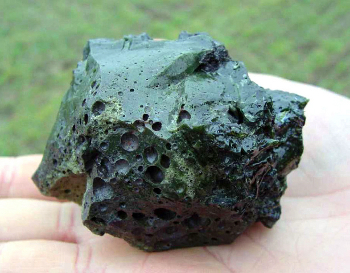Event Location: Field in front of Kuss farmhouse, Golabki, Poland
Date/Time Occurred: July or early August, 1998 (approx. 2:00 am)
Witness: Mrs. Evelina Kuss
Interviewers: Nancy Talbott (July 19, 2003); Robert Bernatowicz (2001)
Translator: Slawek Paruszewski
Materials Sampled: Black/green UFO "stone," field soils
Sampled By: Milosz Kuss ("stone," 1998), Robert Bernatowicz (soils, 2003)
Analyses By: Nick Reiter (SEM/EDS), Phyllis Budinger (FT-IR)
Original BLT Report: January 30, 2004
Photos: By Nancy Talbott, unless otherwise indicated.
Event Description: Mrs. Kuss, a grandmother who has lived in this rural area of central Poland all of her life, has a bedroom on the ground floor of her farm-house. Her large windows look out across a narrow road to a field about 150m long which ends in an approximately 10m-long area of wild grasses abuting a dense forest. There are only a few other farms in the area and very few people.
 |
|
Mrs. Evelina Kuss, eyewitness to "burning" UFO
landing in her wheat field, 1998.
|
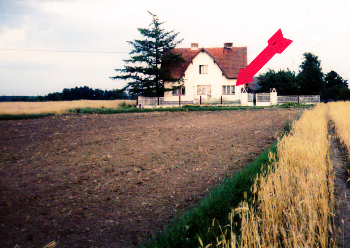 |
|
Mrs. Kuss' bedroom windows, Golabki, Poland.
|
Mrs. Kuss reports that it was about 2:00am early one morning in July (or perhaps early August) of 1998 and she was unable to fall asleep:
"I don't know why, but I couldn't. And suddenly my room became all red...the whole room became red, because there was something glowing outside the window. I saw this object in the sky. It had the shape of an ellipse and [it] glowed in red, a very intense red...And it was very slowly lowering itself onto the field. The glow from this thing was enormous. The whole object was emitting such light that it reminded me of a bright ball, but with a distinctive shape inside the glow. And it was going down very, very slowly."
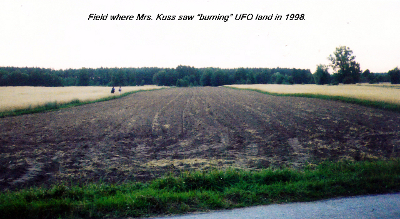 |
|
Field outside Mrs. Kuss' bedroom windows. "Burning" UFO landed at the end,
just in front of the forest.
|
At first Mrs.Kuss thought what she was seeing was a meteorite, but realized this couldn't be because the object was descending so slowly. She states that sometimes it even "stopped" for awhile, and would then continue its descent.
The fiery object, which was approximately 150 meters in front of her windows, appeared to be only 3-4 meters across.
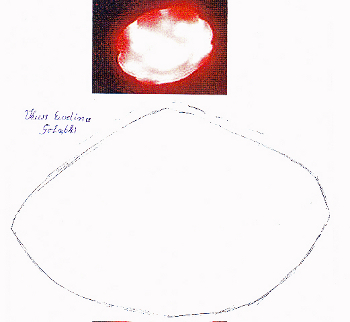 |
|
Evelina's drawing of shape of object; insert at top is to illustrate only
red color and bright "glow" associated with UFO.
|
"I think it could have been several meters in length... I saw it very clearly, it wasn't very far away, glowing like a piece of [hot] iron. There was wheat [in the field, at that time] which my son had sown, but it hadn't been reaped already...and I thought that, since the fire landed there, the field might catch on fire from it.
I even wanted to wake up my family, but the light began to dim. It was dimming out very, very slowly and I saw that nothing was on fire, so I went to bed and in the morning during breakfast I told my family about it. I said that this object had landed there. And I showed them exactly where it landed."
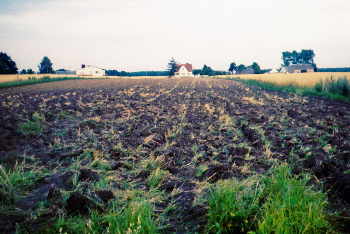 |
|
Far end of Kuss family's field where UFO landed after taking
15 minutes to descend and land.
|
Mrs. Kuss reported that about 15 minutes elapsed from the moment she first saw the red glow in her bedroom until the object landed and then became so dim she could no longer see it. She continued to watch the field for about another hour before finally going to bed sometime after 3:00am. She states that she noticed no unusual smell and experienced no "tingling" of her skin or other physical effects frequently associated with exposure to electromagnetic energies, and she doesn't recall hearing any unusual animal noises.
The object itself was silent. There are no street lights in her area and none of the lights in her house (or the radio or TV) were on, so she is unaware of any electrical interference which may have been caused by the object. The only clock observed in the house was hand-wound and reportedly was not affected.
Retreival of "Stone" by Grandson, Milosz: At breakfast a few hours later Mrs.Kuss told her son, daugher-in-law and grandson Milosz what she had seen the night before, explaining exactly where the UFO had gone down. After attending to his farm chores Milosz, who was 11 years old at the time, walked down to the end of the field to see if he could find any evidence of what his grandmother had seen just a few hours earlier.
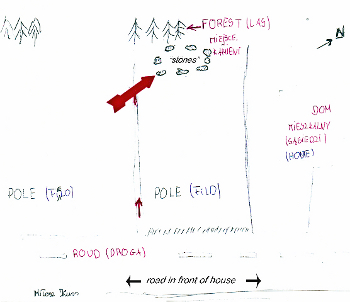 |
|
Milosz's drawing of "ring of stones" he found at end of field, only hours
after Evelina saw UFO land there.
|
There is a 10m-long area of wild grasses at the far end of the plowed field, just in front of the dense forest. Milosz reported that he saw no sign of anything having been burned, instead finding approximately 10-15 "stones" placed in an "irregular" circle or ellipse on top of the grassy area.
"I knew straight-away that they had to have something to do with the object. There were several of them...mostly the size of a basketball, maybe slightly smaller. They made an irregular circle...scattered somewhat irregularly, as if by chance -- or as if someone had put them there delicately. Their weight pressed the ground beneath them a little. There were no traces of anything burnt. There was this smallest stone in the middle [of the irregular ring of stones] and I took it immediately.
But the other stones were very heavy and I couldn't lift them [Milosz was 11 years old at the time]. They were dark green in color, like a green glass bottle, and they were somewhat oval in shape...as if something solidified in huge drops. Their color was exactly the color of the stone I took."
 |
|
Close-up of black-green "stone" clearly showing glassy surface & multiple circular
indentations, indicative of gaseous expiration during cooling.
Photo: Nautilus Foundation
|
Milosz brought this one "smaller" stone back to the house and told his family what he had seen. A day or two later he took a wheelbarrow with him down to the end of the field in order to pick up the rest of the "stones," but when he got there they were all gone. When I asked if people could have taken them away Milosz thought this was highly unlikely:
"People? I don't think so...this is a wild, uninhabited place. Nobody walks here. Who would go into our field and take such heavy stones? I don't think they were taken by people, but rather by an object similar to the one that landed here."
Milosz' parents confirmed there were very few residents nearby and that the only people who went into their fields were they themselves, when they had work to do. Other farmers in the region would have been busy with their own crops and Mr. and Mrs. Kuss knew of no one who might have even known about Evelina's sighting or Milosz' discovery of the stones.
Milosz reported a few additional details, in particular the fact that the one stone he had retrieved "glowed." He said it had sharp edges all over it and that the "glowing points" were on these edges. He also said it continued to glow at night for about half-a-year:
"This is the most important part. I noticed the following night...that this stone gives away a delicate glow at night. I mean, the light was greenish and only the edges were giving away the light. They [the lights] were like small glowing flames, or sparkles...it's hard to describe, but it was amazing."
The rest of the stones were about as big as cinder-blocks, with some rough edges like the smaller one Milosz had retrieved -- and they were all the same dark greenish color. The piece Milosz recovered was more black than green by 2003, but still had multiple light-green inclusions which were visible in good light. Since it appears that all of the stones may have been fluorescing when first seen, this may be why Milosz describes them as basically green, rather than black.
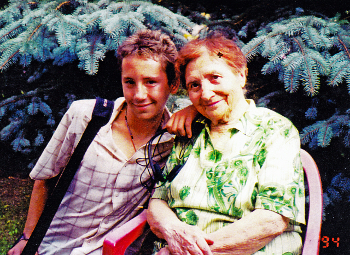 |
|
Milosz and his grandmother Evelina Kuss in July, 2003.
(Date-stamp on NT's photo is incorrect.)
|
By the late summer of 1998 Milosz and his family had been unable to find anyone interested in investigating this event (in spite of the fact that by then other people had also begun reporting a number of strange events in the surrounding area). The family did mention the situation to a few neighbors, but found that they were laughed at and their report not taken seriously.
Sampling: In the summer of 2000 a large crop circle had appeared in the not too distant village of Wylatowo (the first crop circle reported in central Poland) and a photo had been printed in many Polish newspapers, attracting the attention of Warsaw radio reporter (now a Warsaw TV news anchor) Robert Bernatowicz. Bernatowicz, who had organized a group to investigate various unexplained phenomena (The Nautilus Foundation), visited Wylatowo to examine the newly-reported crop circle personally and soon also met Milosz Kuss.
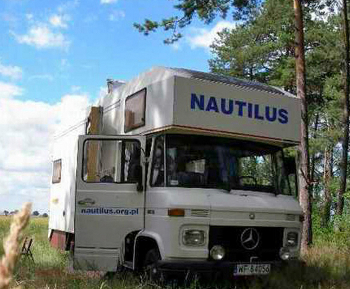 |
|
The Nautilus Foundation's mobile van on a field-trip in
rural Poland. Photo: Unknown
|
Milosz related his grandmother's UFO sighting and his retrieval of the "stone" to Mr. Bernatowicz, who then conducted in-depth interviews with Milosz, Evelina and others in the area, documenting as many details as he could. Then, since he wanted scientific testing carried out on the "stone" (unavailable to him in Poland), Bernatowicz asked BLT Research for technical assistance.
BLT requested two samples of the stone, taken from representative areas of its surface, as well as soil samples taken from the grassy area where the stone had been found and also from the plowed field. In the spring of 2003 two soil samples were taken, both at a depth of about 4 inches -- one from beneath the grassy area and the second from the middle of the plowed field, about 25m from the grassy area and closer to the farmhouse. All samples were then shipped to BLT in the U.S. and received in June, 2003.
SEM/EDS Analysis
On June 3, 2003 the two "stone" fragments were submitted to BLT consultant Nick Reiter of the Avalon Foundation for SEM/EDS. A few weeks later the soil samples were also sent to Mr. Reiter, whose report follows.
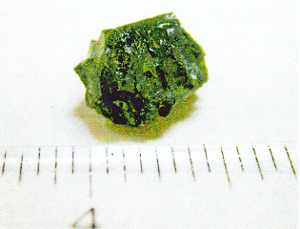 |
|
Lab photo of larger of two samples of Poland stone.
Sample = 1.2 cm. Photo: Nick Reiter
|
 |
|
Both stone samples (in this lighting glassy surface appears black).
Photo: Nick Reiter, 17 June 2003.
|
Physical Form: As can be seen in the above photos the larger sample (before being split in two) was approximately 1.2 cm long, the smaller slightly less than 1 cm. Both are seen to be of similar color, a very dark green-black. We also observe that small ( 2mm) bubbles and voids are present in both, consistent with the immediately apparent likelihood that these samples are essentially glass.
Comparative Analysis: EDS scans were taken from assorted spots on both samples and are quite consistent. We find Si (silicon), O (oxygen), Al (aluminum), Mg (magnesium), Ca (calcium), K (potassium) and minor amounts of Fe (iron) and Ti (titanium).
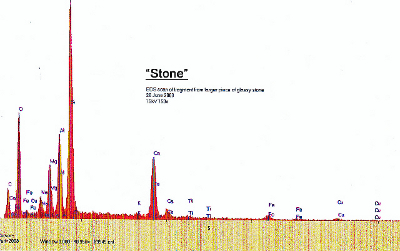 |
|
EDS scan of larger sample of glassy stone (150x 15kV). This scan is
consistent with multiple others conducted on both samples.
Scan: N. Reiter, 26 June 2003.
|
Other Properties:
|
(1)
|
No noticeable radioactivity observed upon tests with Geiger-
counter;
|
(2)
|
No fluorescence was observed in the visible portion of the
spectrum when samples were exposed to both long-and short-
wave UV;
|
(3)
|
Neither sample was magnetic.
|
Discussion: Two analogous materials may be found which resemble these samples. A semi-precious gemstone originally derived from ancient meteoric glass in the region of the Moldau River -- called "Moldavite" -- resembles our samples somewhat in form, but not necessarily in color, as Moldavite is usually a brighter and lighter green. However, these samples do very much resemble vitrified soil, produced by a well-known toxic or nuclear waste remediation process known as ISV or "in-situ vitrification."
In this process electrodes are driven down into the area and electrical arcs are made to flow deep into the soils contaminated with toxic wastes or radioactive substances, liquifying the soil components and producing a non-permeable glassy material as the liquid soils cool. Once cooled this glassy residual can then either remain safely underground (since the toxic or radioactive wastes are now contained and cannot leach into groundwater or spread contamination) or they can be subsequently safely hauled away.
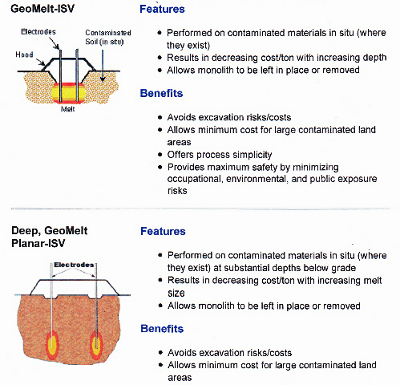 |
|
Features & benefits of two different technolgies for in-situ vitrification, developed
by Geo-MeltTM Corp. Source: GeoMelt Technologies.
|
Additional Testing: The observation by Milosz Kuss (who found the glassy rock) that he saw a long-term phosphorescence or fluorescence continued to intrigue us. We requested an additional sample, specifically from the lighter-green "veins" reported to be visible in the stone and, in December 2003, we received an additional small (< 2mm diam.) light green glassy shard for analysis.
EDS revealed the composition of this new sample to be quite similar to the samples already examined. However, SEM photography revealed that this shard was quite "foamy" in appearance, infused with tiny air-bubbles and voids, typical for ceramics. These air bubbles are thought to account for the overall much lighter-green coloration in some areas of the retrieved stone.
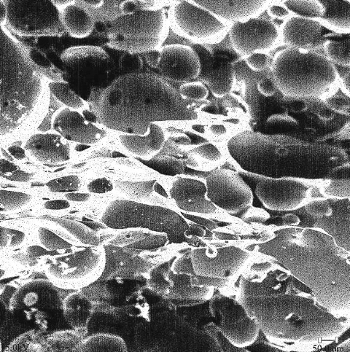 |
|
SEM photo (100x) of small lighter-green glassy shard showing
multiple tiny air bubbles in sample.
SEM Photo: N. Reiter
|
The new sample was also examined under long- and short-wave UV lamps, but no fluorescence was noted. This suggests that the original "luminous" quality reported by Milosz was short-lived and non-reversible. This sample was also examined by Geiger-counter, with no rise in count-rate over ambient noted.
An anecdote from this researcher's past may, though, be germane. In years past I (Nick Reiter) had worked at a major glass company in Toledo, Ohio as a technician involved with vacuum depositing of coatings on large-area glass sheets. One of the materials we coated onto glass was a thin film of fused silica (SiO2) as a wear-resistant coating.
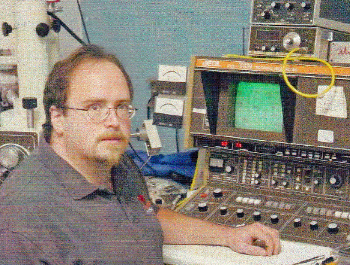 |
|
Nick Reiter at SEM/EDS in Toledo, Ohio.
Photo: Avalon Foundation
|
The process was performed in a huge vacuum chamber, where silica sand was evaporated by electron-beam sources. Regularly we would have to shut the system down after a production run and go inside the cavern-like chamber to clear off the cooling shields and chamber walls. One anomaly we observed, which was never adequately explained, involved a faint greenish glowing of the flakes of "over-spray" glassy fused silica on the cool chamber walls. On one occasion we observed this faint glowing up to 24 hours after shutting the evaporation sources down.
Thus, although the reported anomalous glowing of our Polish fused glassy stone over a period of months is extra-ordinary, I have personally observed the glowing of vaporized and condensed fused silica for periods of multiple hours. Perhaps some analog is present.
Soil Analysis: EDS analysis of granular soil tends to be somewhat problematic, due to the physical heterogeneity of such samples (except in the case of fine clays). "Dirt" is a complex material, and usually requires several EDS scans from each sample to get an idea about overall composition.
Examination of the soil sample taken from the grassy area where the stone was found shows a sandy or coarse-grained silty soil. EDS shows normal soil ingredients, primarily Si, O and Al; Ca, K, Fe and Mg are seen as minor peaks. EDS of control soil taken 25m away (from the plowed section of the field) is ratiometrically similar to the stone-area soils, with very similar signals of Si, Al; (which is slightly elevated over the rock-area soil), O, Ca, K, Fe and Mg, but with traces of Mo (molybdenum) and P (phosphorus) which were not seen in the stone-area soil.
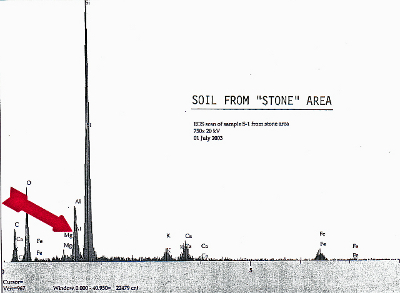 |
|
EDS Scan of soil (750x 20kV) from stone area shows typical soil ingredients,
primarily Si, O and Al; Ca, K, Fe and Mg seen as minor peaks.
|
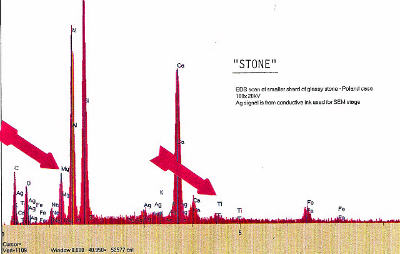 |
|
EDS Scan of stone (100x 20 kV) showing stronger Mg peak, with
presence of Ti (Titanium) seem only in the stone.
EDS scans: N. Reiter, 1 July 2003.
|
We also observe the interesting fact that the composition of the soil from the grassy area from which the glassy stone was retrieved contains most of the same constituents as the glassy stone fragments themselves -- however, not all -- and not in any similar ratio. The glassy stone fragments are much richer in Mg (magnesium), with a minor Ti (titanium) peak visible (likely indicating rutile, a mineral form of titanium dioxide). The soils said to be from the glassy stone area have very little Mg, and no visible Ti.
FT-IR Analysis (Frontier Analysis Ltd.)
On July 8, 2003 a fragment of the "stone" retrieved from a farm field in Poland in 1998 was received by Phyllis Budinger, Frontier Analysis Ltd. laboratory in Chagrin Falls, Ohio for additional infrared spectroscopy analysis. [Infrared spectroscopy identifies materials on the molecular level by measuring the interaction of the molecules at wave-lengths in the infrared region of the EM spectrum. The spectra produced provide a unique profile of the molecule.]
 |
|
Photomicrograph of stone fragment showing apparent
bubbles. Photo: P. Budinger
|
Procedure: The dark "stone" fragment is approximately 9 x 7 x 2mm and weighs 0.2358 grams. An infrared spectrum was taken of a tiny amount of ground material removed from the fragment, using the Harrick SplitPeaTM accessory on the Nicolet Avatar 360 spectrometer. Steromicroscope photos were obtained using the Leika GZ6 microscope interfaced to a Kodak Digital Science MDS 120 camera.
Results: Microscopic analysis shows the material has a glassy appearance with some apparent bubbles. This would suggest the material has been exposed to a temperature high enough to cause "melting" of the mineral silicate in the sample (see infrared analysis, below, regarding the identification of glass-like Si-O bonds, and Nick Reiter's report, above).
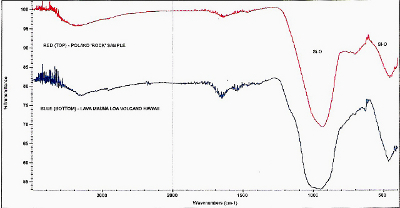 |
|
FT-IR spectrum of the stone sample (in red) compared with a reference spectrum
of lava (blue) from volcano on the island of Hawaii.
FT-IR spectrum: P. Budinger
|
The infrared spectrum of the stone fragment shows very broad absorption bands which are very typical of an amorphous glass-like substance. The frequencies of the bands (between 1050-900 cm-1 and 550-400 cm-1) are definitely due to Si-O absorption. The spectrum is a close comparison to a spectrum of lava, which is rock that has experienced melting (Lava specimen used in this comparison is from Manua Loa on the island of Hawaii).
These data suggest that this sample stone fragment originally contained a high concentration of silica mineral (i.e., sand -- a.k.a. quartz) that has been subjected to high temperatures. Glass (manufactured from 75% silica + other minerals) requires temperatures of a least 700-800 degrees celsius (1300-1500 degrees farenheit) in order to become glass (Lewis, Richard K. Sr., Hawley's Condensed Chemical Dictionary, 14th Edition, John Wiley & Sons, Inc., 2002).
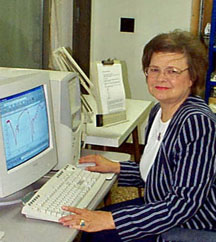 |
|
Phyllis Budinger, Analyical Chemist,
Frontier Analysis Ltd.
|
 |
|
Frontier Analysis Ltd. Infrared Spectrometer, printer & computer
which runs the FT-IR. Photo: P. Budinger.
|
- CONCLUSIONS -
SEM/EDS ANALYSIS:
|
(1)
|
By all indications the glassy "stone" samples provided are most likely
highly-vitrified soil. The source of this vitrification/conversion to a glass
remains unknown.
|
(2)
|
The lighter-green areas of the "stone" (said to have fluoresced at the
time of retrieval and for several months following) are comprised of
essentially the same elements as the darker areas, but contain multiple
tiny air bubbles and voids which account for the lighter color in these
areas.
|
(3)
|
The composition of the soils from the area where the glassy stone was
found and the control soils from 25m away is very similar, representing
typical soil components.
|
(4)
|
The EDS scans of the glassy stone samples and the soils from the area
where they were found do not resemble each other radiometrically -- indicating that the vitrified stone was probably not derived from soils indigenous to that precise location.
|
---Nick Reiter, The Avalon Foundation
INFRARED & MICROSCOPIC ANALYSIS:
Infrared (FT-IR) and microscopic examination of the "stone" sample shows an amorphous and glassy Si-O containing material. Clearly the data supports Nick Reiter's conclusions that this sample is soil that has been vitrified.
---Phyllis Budinger, Frontier Analysis Ltd.
[The complete FT-IR report on the Golabki "stone" analysis can be found here:
Budinger/UT030.pdf.]
_____________________
- PART 2 -
Unexplained "Drilled" Hole Found in Dabrowka, Poland
Following UFO Sighting - 2003
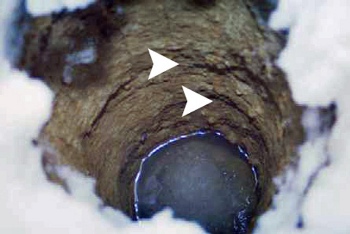 |
|
"Drilled" hole found January 29, 2003 in Dabrowka, Poland
after UFO hovered over area for 15 minutes.
Photo: Adam Piekut (1/29/03)
|
The fact that the vitrified stone found in Golabki contained most of the same normal soil constituents as did the control sample from the field where it was found -- but "not in any similar ratio" -- indicates that the soil which had been vitrified came originally from somewhere else, probably not too far away. The discovery by the Nautilus Foundation of multiple unexplained (some very deep) apparently "drilled" holes in various rural locations in Poland, reported over a period of years (one of them in the village of Dabrowka, not far from Golabki), may provide a clue.
At about 5:20pm (dusk) on January 28, 2003 Zofia Marciniak, a resident of Dabrowka, Poland, was in her yard exercising her dog when she saw a "very bright" 1/2-meter long triangular-shaped object hovering just at treetop level over the field next to her home. The object, which hovered silently about 200m away from the witness, was covered with many multicolored lights ("red, yellow, green and blue and all the same size,"...like a "Christmas tree") and remained stationary and visible for about 15 minutes. Mrs.Marciniak said that the edges of the triangular UFO were indistinct and that her dog did not bark during the incident; in fact, she's not sure exactly where the dog was during the time she watched the UFO.
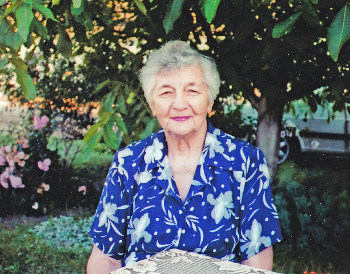 |
|
Zofia Marciniak, Dabrowka, Poland-witnessed triangular UFO
silently hovering over field next door around dusk.
Photo: Adam Piekut
|
 |
|
Mrs. Marciniak's drawing of silent "Christmas Tree" UFO she
watched for 15 minutes on Jan. 28, 2003.
|
Of interest also is Mrs. Marciniak's report that she had felt something "pressing on her head" which began during the morning hours prior to her actually seeing the UFO at dusk, and that this pressure "intensified" when she actually saw the object in the sky. She was certain this is the only occasion in her life when she experienced this feeling of "pressure."
[This physical experience of an unusual pressure when in proximity to UFOs has been repeatedly reported in other incidents: see another Polish case in 2000 involving not only a UFO and unusual "pressure" experienced in the body of the eyewitness, but also the appearance of a new crop circle as the UFO departed: bltresearch.com/eyewitness/eyewitness2.
For multiple other reports of proximity to UFOs and/or crop circles resulting in the experience of an unusual sensation of "pressure" on the witnesses' bodies, see reports of Dutch incidents, listed at the bottom of the "van den Broeke case" page on the BLT website: bltresearch.com/robbert. In particular this was reported in conjunction with one crop circle event in 2007 (bltresearch.com/robbert/hoeven2007cc) and then in another event that same summer when the witness experienced a "heavy pressure" while actually standing in the field as a 4th crop circle then appeared nearby (bltresearch.com/eyewitness/eyewitness8a).
Also in Holland in 2012 there were reports of strong "pressure" experienced in conjunction with the presence of UFOs and/or the occurrence of new circles forming: dutchoverview2012p2 & dutchoverview2012p5.]
After watching the "Christmas Tree" UFO for about 15 minutes Mrs. Marciniak went back to her kitchen to take something off the stove, returning to her back-yard after 2-4 minutes to find that the UFO was not visible at first -- but then reappeared farther away and more to the right. When it reappeared the lights were at first all white, but then became colored again. Then the lights gradually dimmed and went out over a period of about one minute and the object was gone.
She had heard that UFOs had been reported by other residents in her general area and assumed this might be what she had seen, but states she was more curious than afraid. She also reported that she had noticed helicopters flying low over her area on-and-off for 2 years prior to her sighting -- and that she then noticed many "long, skinny planes" which looked abnormal to her, flying below the treetops in the same area immediately afterward ("more planes than before").
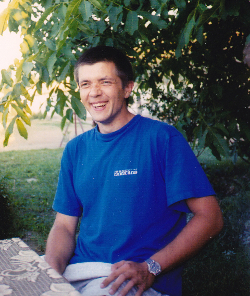 |
|
Mrs. Marciniak's grandson, Adam Piekut, who found
hole in field over which UFO had hovered the
night before. Photo: Unknown
|
Later that night, around 9:00pm, Mrs. Marciniak called her grandson, Adam Piekut, and told him what she had seen. Adam arrived the next afternoon and went into the field to see if any physical evidence might exist which could be related to the UFO's presence. Since it was the middle of winter deep snow covered the fields and he expected that any unusual markings or tracks would be clearly visible.
What Adam found in the fallow field -- directly beneath where his grand-mother indicated the UFO had hovered -- was a 30cm-diameter round hole which he measured to be in excess of 5m deep, with about 1m of standing water at the bottom. And, although it appeared that the hole had been "drilled" (he could see a "spiral threading" inside the hole down to the water level), he could find no remnants of the dirt which must have been removed to create it. There was absolutely no soil scattered anywhere over the snow-covered field or around the hole itself, nor could Adam understand how there could be water present in the hole in January, when the temperature was below freezing.
In late-April, 2003, Adam took a soil sample from approximately 0.5m down inside the hole and a "control" sample from surface soil from the field about 10m away from the hole.
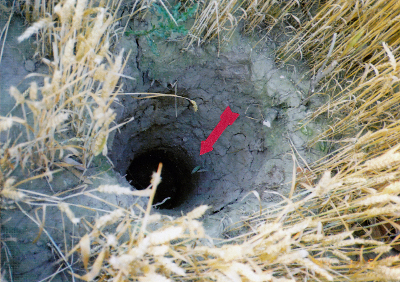 |
|
Arrow points to spot 0.5m down inside hole where Adam took sample for BLT
in late April, 2003. Photo: N. Talbott (July, 2003)
|
 |
|
Control soil is homogeneous; soil from Dabrowka hole
is heterogeneous, with many clumps.
Photo: Frontier Analysis Ltd
|
The FT-IR and EDS analyses both show the "control" sample to contain typical elements found in quartz, including major amounts of silicon, aluminum and oxygen with small amounts of iron, potassium and magnesium. Conspicuously absent are kaolinite and calcium carbonate, which are present in the sample from inside the hole.
The hole sample is composed primarily of quartz, kaolinite clay and a smaller amount of calcium carbonate, with minor amounts of other minerals.
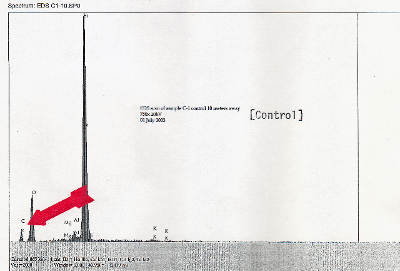 |
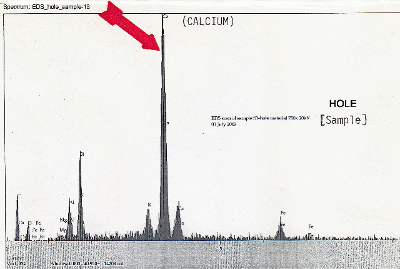 |
|
EDS shows differences between surface soils in Dabrowka field & soil inside hole.
Because samples came from different depths, no significance can be
attributed to these results. Graphs: N. Reiter.
|
Because the "control" sample was taken from surface soil and the hole sample taken from approximately 0.5m down inside the hole, the differences noted by the EDS and FR-IR tests cannot be clearly evaluated. A true "control" should have been taken at the same depth as the hole sample.
Additionally, for such testing to produce significant results multiple samples from various depths inside the hole (as well as from around its surface), as well as multiple controls taken from the same depths and at various distances out into the field, would be required. In this case it would also have been of interest to have had samples of the water seen in the hole when first discovered.
The FT-IR work looked, specifically, for the presence of calcium oxalate since soil samples from another UFO-related case previously submitted to Frontier Analysis Ltd. had revealed that substance; in this Dabrowka case none was found. Also, no radioactivity was found in either the hole or the "control" soil samples.
The complete FT-IR report on the Dabrowka soil analysis can be found here:
Budinger/UT035.pdf.
___________________
Since the UFO-related "vitrified stone" Golabki event occurred in late summer of 1998 and the UFO-related unexplained hole was found in the nearby village of Dabrowka in January of 2003, it is obvious that the soil from the Dabrowka hole could not have been the material which had been vitrified to create the Golabki "stone." However, once the Nautilus Foundation's interest in these unusual phenomena became known they were notified of many very strange, often quite deep, inexplicable holes which had been both previously (as well as currently) discovered in various parts of Poland.
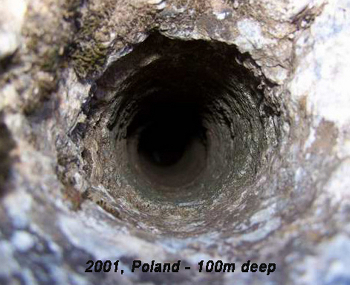 |
|
Another unexplained hole found in Poland in 2001, also apparently
"drilled" & with no excavated soil found in area.
Photo: Nautilus Foundation
|
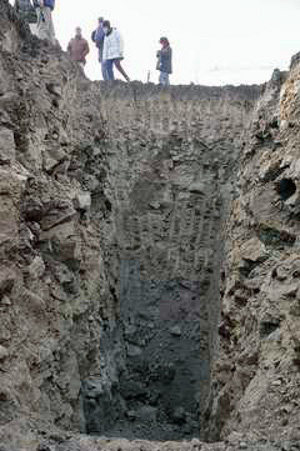 |
|
Another anomalous Poland hole was excavated
to determine its depth.
Photo: Nautilus Foundation
|
 |
|
As late as 2006 this smaller (6-inch diameter) but very deep hole
was found near Leszczyny, Poland.
Photo: Nautilus Foundation
|
Did the soil which had been vitrified to form the "stone" recovered by Evelina Kuss's grandson Milosz in Golabki come originally from one of these many other unexplained holes -- and, if so, what might this mean? Are these holes created by UFOs? Are soil samples being taken? And then vitrified? For what purpose? And if UFOs are involved is creating even some of the holes, and are then responsible for vitrifying at least some of the soil content of those holes, why were 10-15 vitrified "stones" originally deposited in the Golabki field? And, perhaps more curiously, why were all of those stones -- except for the smaller one retrieved by Milosz Kuss -- then quickly (and apparently surreptitiously) removed?
_________________
|
